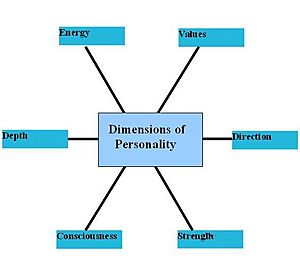Personality psychology facts for kids
Personality is how we describe the special ways a person usually thinks, feels, and acts. It's like a unique pattern that stays pretty much the same over time and in different situations. When we understand someone's personality, it can help us guess how they might act. This makes it easier to understand why people do what they do. Personality can also give us clues about a person's inner thoughts, feelings, and actions.
Contents
Old Ideas About Personality
Main article: Four temperaments
Long ago, a famous Greek doctor named Hippocrates had his own ideas about what made up a person's personality. He thought our bodies had four main liquids, called "humors": yellow bile, black bile, blood, and phlegm. Hippocrates believed that if one of these liquids was out of balance, it would affect a person's personality and even make them sick.
He linked each humor to different elements and types of personalities:
- Blood was connected to air. Too much blood meant a person was sanguine, which meant they were hopeful and cheerful.
- Black bile was connected to earth. Too much black bile meant a person was melancholic, which meant they felt sad or gloomy.
- Yellow bile was connected to fire. Too much yellow bile meant a person was choleric, which meant they were easily annoyed or aggressive.
- Phlegm was connected to water. Too much phlegm meant a person was phlegmatic, which meant they were calm, quiet, and sometimes a bit lazy.
Hippocrates thought that if these humors weren't at the right levels, people would show these personality types or even get sick.
Different Ways to Study Personality
When we study personality, we look at many different ideas to understand how it forms. Some of these ideas include trait theory, the power of motives, evolutionary ideas, and social learning. Each of these tries to explain how our personality develops and what influences it.
Trait Theory
Trait theory suggests that our personality is made up of "traits" and "types."
- Types are like big, separate groups. For example, you are either a cat or a dog, you can't be both.
- Traits are qualities that people have, but they can be measured on a scale. Think of it like a dimmer switch for a light. You can have a little bit of a trait or a lot of it.
Examples of traits are things like being fair, smart, confident, or helpful. Everyone has these traits, but in different amounts.
There are two main ways to look at traits:
- Nomothetic view: This idea says that traits are common to everyone. We can compare how much of a trait different people have. It also means that each person has a special mix of these common traits.
- Ideographic view: This idea says that traits are unique to each person. It's harder to compare people because not everyone shares the exact same traits, or the traits might be more important for some people than others.
Motives
Motives are another important part of personality. They are like inner forces that push us to do things. These forces come from a "need," which is something we require, like food or safety. When we have a need that isn't met, we feel a motive to fulfill it.
For example, everyone needs water. If you haven't had water for a while, you'll feel thirsty. Thirst is the motive that makes you want to drink. A "press" is something outside of you that makes a motive stronger. If you're thirsty and you see a cold glass of water, that glass of water is a press that makes you want to drink even more.
An "incentive value" is how much a certain action will satisfy a need for a person. What feels really satisfying to one person might not be as satisfying to another. Everyone has different incentive values.
Evolutionary Ideas
Another idea about personality is that it's something we inherit, meaning it's passed down through our genes. People who support this idea believe that our personalities have changed over a very long time to help us survive and have children.
Social Learning Theory
Social learning theory suggests that our personality is shaped by our experiences. This includes our relationships with others, the places we live, and the social world around us. We learn how to act and think by watching and interacting with others.
Main Personality Types
Through lots of studies, experts have found five main personality traits that are very important. These are often called the 'Big Five':
Neuroticism
Neuroticism is about how emotional a person is. Someone who scores high in neuroticism might have trouble controlling their feelings. They might often feel nervous, worried, or easily upset. They could also be prone to feeling sad, self-conscious, or stressed.
Extroversion
Extroversion is also known as sociability. This trait describes how outgoing and energetic a person is. Someone high in extroversion is usually very friendly, positive, and loves to seek out exciting experiences. They enjoy being around people.
Openness
Openness is sometimes called the "intellect" factor. It's about being open to new ideas and experiences. A person high in openness is often very creative, curious, and has a good imagination. They like learning new things and trying different activities.
Agreeableness
Agreeableness is about being friendly, kind, and easy to get along with. Someone high in agreeableness is usually considered friendly, thoughtful, and good-natured. They care about others and try to avoid arguments.
Conscientiousness
Conscientiousness is about being responsible and having a strong desire to achieve goals. A person high in conscientiousness is often careful, likes to plan things, is serious, and works hard to get things done.
See also
 In Spanish: Psicología de la personalidad para niños
In Spanish: Psicología de la personalidad para niños


